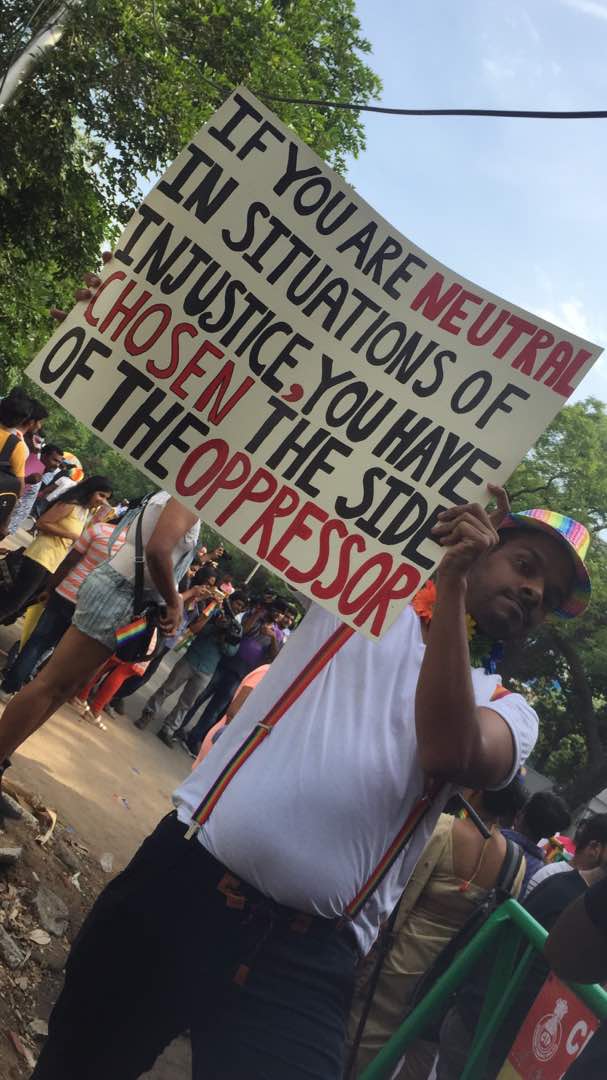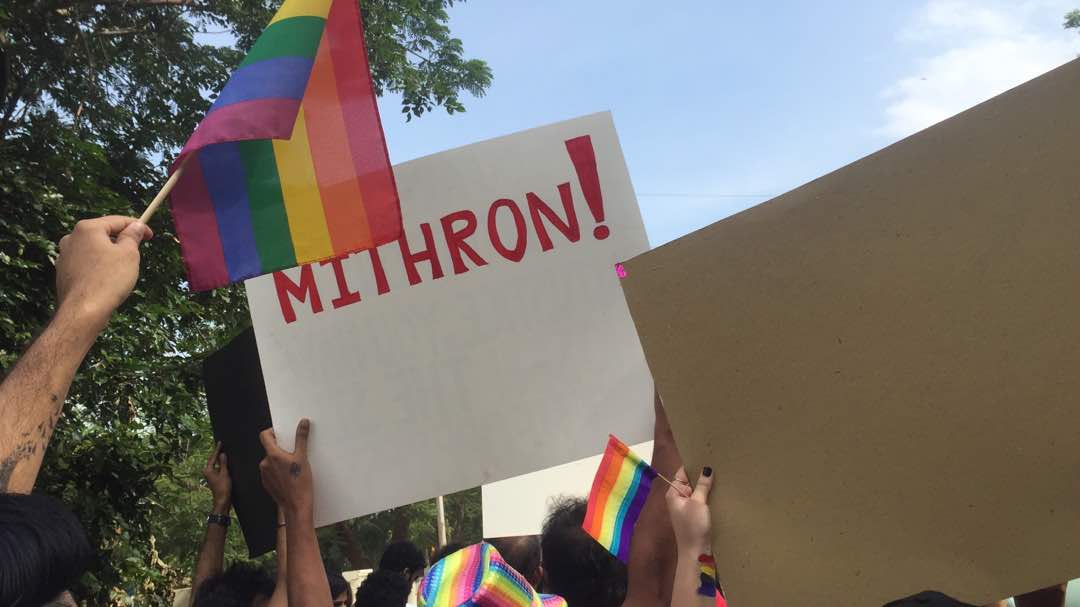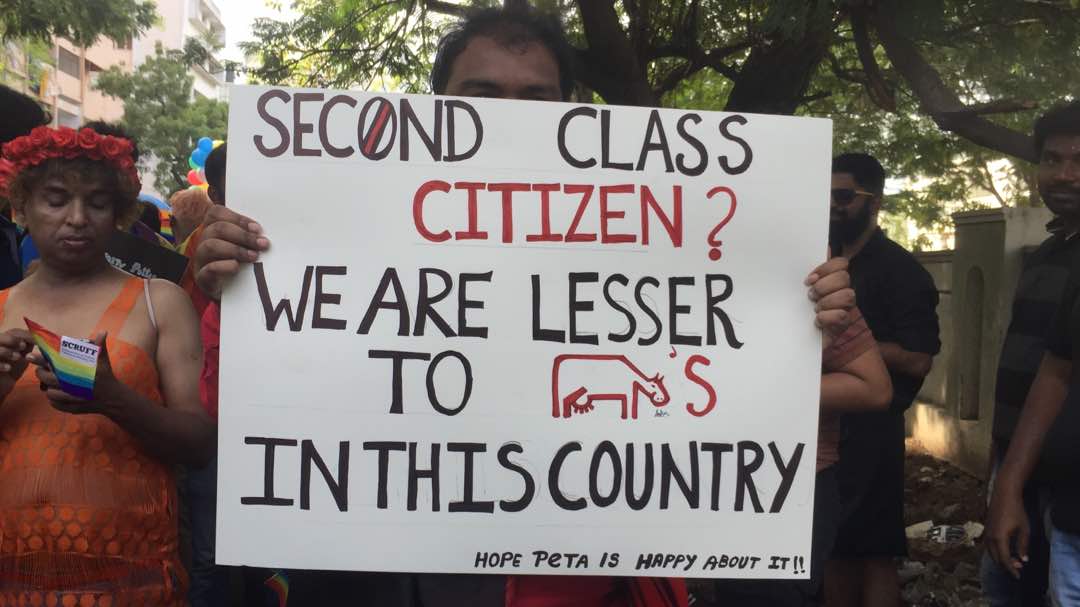I am still exhilarated from the Chennai’s ninth Rainbow Pride parade that we celebrated on the 25th June this year. Contrary to the popular belief that the Pride parades are exclusionary, the Pride parade in Chennai tries to be a space that has people from all walks of life. Since the parade route was moved to the Pudupettai stretch, there have been complaints from certain quarters about how ‘cheap’ the parade is. This year, there wasn’t any major discussion regarding the route; thanks to the Jallikattu protests earlier this year. Because of which, the city police do not allow any sort of mass gathering in either in Marina or the Besant Nagar beach on any day.
But one could hear comments from some attendees on how ‘invisible’ the route is. I know they would eventually learn how inclusive the route is. Also, the stir created by Chennai Rainbow Pride through its placards and press release this year among certain sections of the LGBTQIA+ community in Chennai and outside assures me that we did it the right way. But this was not an easy task. We had to fight among ourselves, among friends, burn friendships down to achieve the diversity that we all claim proudly.
The Chennai Rainbow Pride parade is being organised by (TNRC). TNRC consists of Individuals who work for LGBTQIA+ rights – Queer individuals and Allies, collectives and NGOs in Tamil Nadu that work to raise visibility around sexuality and gender identity issues. From 2009 till 2013 the Pride parade was organised under the banner Chennai Rainbow Coalition, which was expanded to TNRC by the end of 2013 in response to the need for consolidated effort from throughout the state after the Supreme Court’s verdict on Section 377 which was delivered on 11th December 2013. The coalition was formed to appreciate and have a larger community involvement. The idea and the structure of the coalition is well thought. Pride belongs to everyone and cannot be claimed by any individual or organisation.
Personally, I felt that this year’s Pride parade in Chennai was more politically charged than the previous ones. The larger political scenario in the state and the country was one of the primary reasons for the increased vocal assertion. There were slogans and placards against the raising right-wing politics and Hindutva, Hindi imposition and cultural erasure. All these burning issues were mentioned in this year’s press release for Chennai Rainbow Pride.
As expected, this did not sit well with some in Chennai and there was a visible backlash from other cities criticising Chennai queer politics for diluting the LGBTQIA+ ‘cause’. Gireesh, a Chennai based artist and poet who was involved in organising Chennai Rainbow Pride in the initial years carried a placard that read, “If you are Neutral in situations of injustice, you have Chosen the side of the Oppressor,” a historical quote by South African social rights activist Desmond Tutu. Gireesh said that the message was for both the Queer community and the larger society. He points out the exclusionary politics within the Queer community that keeps critical voices at bay. But his criticism is at individuals – mostly his friends – who turn a blind eye towards such instances.

Poster at Chennai Rainbow Pride 2017 (Picture by: Moulee)
The backside of his placard read “Mithron” (with an H), a tongue-in-cheek reference to Hindi imposition. The language issue is also reflected within the Queer community while having a national level discussion. There were times when slogans in Hindi would be suggested for nation-wide protests. Those who question the necessity to talk about language politics in the Pride parade must understand that Hindi imposition is a real issue which affects the Queer community in Chennai as we replicate the larger setup of the Union of India.

Poster at Chennai Rainbow Pride 2017 (Picture by: Moulee)
The visible voices of the Chennai Queer community, especially individuals who do not associate with collectives and NGOs, are politically evolved and progressive. But the parochial outlook still lingers when we step inside the community. This could be primarily the fear of losing the hold of the roost or the threat of the right-wing politics which lingers around. In late 2014, the community decided that the Queer movement in the state would align with Tamil Nadu’s self-respect movement. Subsequently the Pride parade name in Tamil was rechristened to ‘Vaanavil Suyamariyathai Perani‘ (Rainbow self-respect Parade) from 2015. But ever since the announcement, we get opposing voices from individuals and groups on the necessity to align or associate the Pride parade with ‘Self-respect’ movement.
The participation of a lot of individuals from diverse background made the parade successful. It is an undeniable truth that a lot of effort was put in to pull this celebratory demonstration. Some individuals who are part of TNRC did feel that individual voices do not carry weight as compared to those who associate with collectives or NGOs. The freedom to express their opinions in the Pride parade is the last hope for some.
Senthil, a communication designer, who was an active member in organising Chennai Rainbow Pride parade and other Queer events until he moved out of Chennai three years ago came down to Chennai to attend the Parade. He said, “The collective or the NGO names should not be highlighted in a coalition. This creates a power play within. The inclusive political parade is what I want but I am against the exclusion that happens within.” He was also particularly not happy when important decision making spaces exclude LGBTQIA+ community members and when the Pride attendees were asked to chant NGO names. Incidentally, Senthil and Gireesh were instrumental in the initial years in designing the masks that are worn in the Pride parades till today.
Additionally, this year the parade also saw a significant participation from the corporate sector. Chennai Rainbow Parade does not allow corporate sponsorship for the event. There are strict guidelines on how corporates can show their support and presence in the Pride parade. Employees are allowed to wear clothing with their company’s brand or logo, but are not allowed to have any sort of branding in their placard or distribute marketing merchandise. PETA which used to carry obnoxious placard with their branding until last year was not to be seen anywhere or I did not come across anyone with PETA placards this year. The only instance of PETA I noticed in this year’s Parade was in a placard which read “Second Class Citizen? We are lesser to cows in this country. Hope PETA is happy about it!” carried by Senthil.

Poster at Chennai Rainbow Pride 2017 (Picture by: Moulee)
Scruff, a dating app for gay and bisexual men, distributed rainbow flags and placards with their name branded on it. The merchandise was swiftly confiscated and discarded by individuals associated with TNRC. The official representative of Scruff expressed his regret for distributing the merchandise and claimed ignorance of not knowing the guidelines of the Pride parade in Chennai. Although he was not happy the way the flags were thrown into the dustbin. Additionally, he also received warning from few individuals associated with TNRC after he posted the picture of the flags in dustbin and complained how the “rainbow flags” were disrespected.
Similarly, The Humsafar Trust from Mumbai carried a banner in the Pride parade. They were asked to not carry any banner as we do not allow any organisations carry individual banner during the Pride parade. It is surprising to note how Scruff and The Humsafar Trust did not know about the guidelines we have in place. This isn’t the first Pride parade in Chennai for the individual who represented Scruff and as of The Humsafar Trust, they do have working and casual contact with NGOs that are part of TNRC. This appropriation and stealing the efforts of many individuals must be condemned. And I personally think both these organisations must officially clarify on the disrespectful incidents.
Greeshma Aruna Rai, an Ambedkarite, carried a placard that read “RSS! We oppose your anti-Muslim, brahminical nationalism project” signed with #QUEERAMBEDKARITES. This was one of the placards that made some gay men call Chennai Rainbow Pride to be a shameful event and divisive. While she is optimistic about the politics that is spoken in the Pride parade, she is strong in her criticism on how the intersectional politics is spoken only during the Pride parade and in the press release. She wants the alliance to be an ongoing effort with the Dalit movement and other marginalised communities.

Picture credit: Moulee
As Greeshma points out, the alliance can be taken forward only if we talk about the structural caste oppression and hegemony within the Queer community. And it must not be tokenism. The homogenisation and the attempt to saffronise the country is also a threat to us. The reluctance to accept diverse faces is one of the reason for homophobia and transphobia. The machismo that is fed in the name of caste, religion and nationalism very much put gender-non-confirming individuals at risk. The necessity to talk about other issues, which most of us are subjected to irrespective of our Queer identity, is important. This would also reiterate and send the message that the Queer community must be given proper representation and authority in policy making and governance.
The criticisms for sure will help us in making the whole space more inclusive. And different perspective and dissents would only make us stronger. The criticisms also show the involvement and the investment that individuals make in shaping the Chennai Rainbow Pride into a successful event. Nilavumozhi Senthamarai, a lawyer based in Chennai, came to the Pride with her three-year-old son. This was the first Pride parade for both of them. Nilavumozhi said “I see gender stereotypes and patriarchy being challenged here. I would want my son to grow up in a society that does not condition him to societal gender norms that are unequal. I would want him to see and grow up with the thinking that you don’t have to dress, walk or talk in a certain way to be a man or a woman. And I believe this would help him understand himself better as he grows up.”
As another first-time participant Shilpa, a doctor, put it; “This is like a festival back home. Getting ready to the parade in itself was an event for me. Here I see people shouting slogans in one corner, and some dancing to the Parai music on the other end. The whole environment gives me the feeling of belonging. I own this space.” I asked if she would be involved in organising the Parade in the future. She replied; “That requires a lot of energy and commitment. I would love to be a part, but I would also like to understand more before I dive in.” I could not end this article on a better positive note that what Nilavumozhi and Shilpa said.
Update: Koninika Roy from The Humsafar Trust clarified that the organization did not mean to disrespect the Chennai Rainbow Pride or the people’s effort. She also made it clear that they were not aware of the guidelines and folded the banner back immediately when they were asked to. She regrets the untoward incident by reiterating that they stand with people’s effort and spirit.
About Author:Moulee works in the tech industry, is a blogger and focuses on intersectional issues within the queer community and workplace diversity.
This post was first published in Feminism in India and has been published here with permission
- An Ecosystem Of Support: In Conversation With The Queer-Trans Wellness & Support Center, Hyderabad - January 10, 2022
- जेंडर के ढाँचे से जूझता मेरा बचपन - April 11, 2019
- Love, Simon Review – A Queer And Wholesome Romantic Comedy - June 19, 2018

